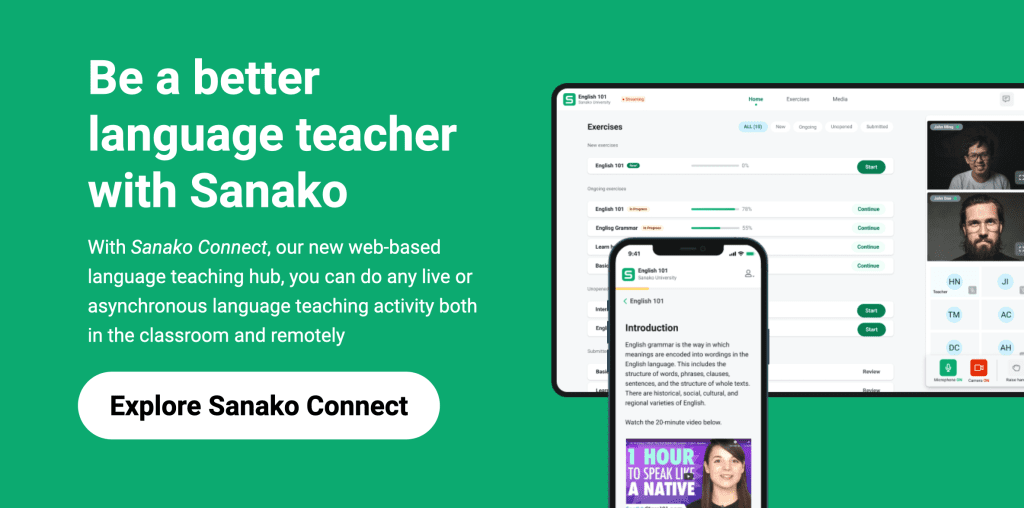Language teachers are calling on an ever-increasing range of digital apps and tools to help them best support students and their learning outcomes. Sanako is in awe of the work that educators are doing, but wonder if using multiple singe-purpose apps is the best way for institutions. Not least because of the implications for school budget and IT infrastructure (security, data management, etc.) that principals and heads of IT / language teaching will need to consider. This blog post therefore looks at the reasons why language teachers are using multiple apps to help their teaching and highlights four key reasons why larger-scale, integrated language teaching platforms (such as Sanako Connect) might actually be the best way forward.
Current teacher behaviour
Language teaching is obviously a struggle for many institutions at the moment and it’s natural to want to equip your staff with all of the tools that they need (or say that they need) to help do the job. But this can mean that schools are buying many different tools to cover every possible eventuality. This might mean that institutions are buying one solution for synchronous live classes and another for asynchronous lessons; a different solution for recording students and yet another to create digital flashcards and so forth.
A different app is seemingly needed for every different part of the job – the list is therefore endless!
Whilst using such a variety of solutions can be a quick fix to solve a problem, Sanako’s experience from working with customers in 50.000 classrooms globally is that it isn’t an effective or sustainable way for schools to operate. Our feedback from schools identifies 4 main benefits of working with larger-scale, single supplier solutions that school principals and heads of IT / language teaching should be aware of.
1. Reduced cost
Although many educational app providers are currently offering free trials or discounts, the cost of using such a wide variety of apps to fill every teacher’s needs can quickly add up. Obviously, this creates additional pressure on already tight school budgets and doesn’t represent good value-for-money if the app is then not used by all language teaching staff.
Conversely, larger solutions with the full range of functionality that schools need are usually able to offer a cheaper overall price, thanks to their size and economies of scale.
2. Time saved
It’s also clear that building up a library of different tools can be a really time-consuming process. After all, the process will include identifying and testing potential solutions, negotiating price and terms before finalising numerous contracts with multiple suppliers. Even when all of the elements have been purchased, significant time will still be required to integrate all of the tools and getting them to work harmoniously. When teachers and all school staff are under such significant pressure, our feedback from school leaders is that this burden is causing unnecessary stress and burnout.
Conversely, institutions find that working with a single expert supplier significantly reduces time spent getting technology integrated. Sanako’s expert global network of resellers are on hand to work with academic customers to identify, source and install the right solution making the whole process more streamlined. Ultimately, this frees up teachers to spend their time in the right areas – working with students to improve their learning outcomes.
3. Improved user experience
Perhaps the most important argument in favour of large-scale, integrated language teaching software tools such as Sanako Connect, is simply that they just work better for teachers and students. Such platforms are able to combine synchronous/asynchronous lesson delivery alongside the best elements of language labs and virtual meeting tools.
Educators can use Connect to upload (and share) all lesson content with students before the lesson starts, including the full variety of content types (e.g text, sound files, web pages, video etc.). Teachers can also use Connect to assign a range of tasks to students that test core skills (reading, writing, speaking and listening) as well as handling student assessment and feedback. In addition, as all content is stored on a single platform, teachers can easily find the information they need and / or can duplicate / rework material at short notice.
As all of the above is seamlessly conducted within a single platform, teachers can concentrate on teaching rather than rotating between different solutions. As a result, students’ attention and motivation is maintained for longer as they’re not distracted by constantly changing windows and resources.
4. Less complicated
A single supplier solution also makes matters more straight-forward behind the scenes as well. Rather than dealing with invoices, data privacy policies, and user agreements from a complicated variety of suppliers, a single supplier solution (such as Connect) inevitably only involves a single invoice and one data policy.
It’s also worth noting that unlike most other solutions, Sanako Connect doesn’t require students to create an account before using the tool. Rather learners just click on a link shared by the teacher to access the learning session.
Importantly, working with a single supplier also means that institutions have an obvious point of contact in the event that support is required. This ensures that any problems can be quickly identified and then easily ironed out.
Interested to learn more how your institution might also benefit from Sanako Connect? Click the button below to explore Sanako Connect and book a FREE remote demo.

